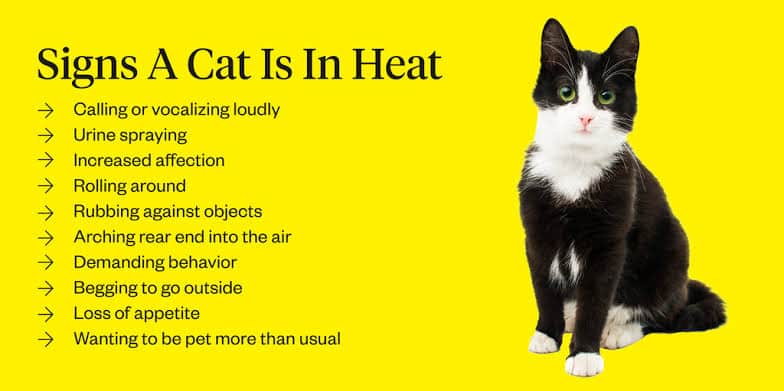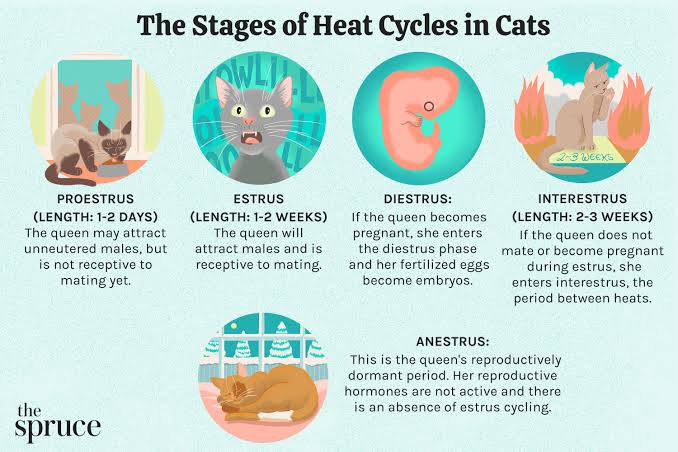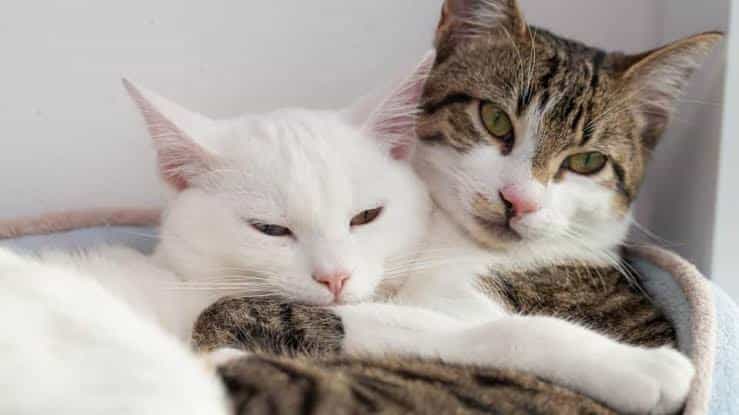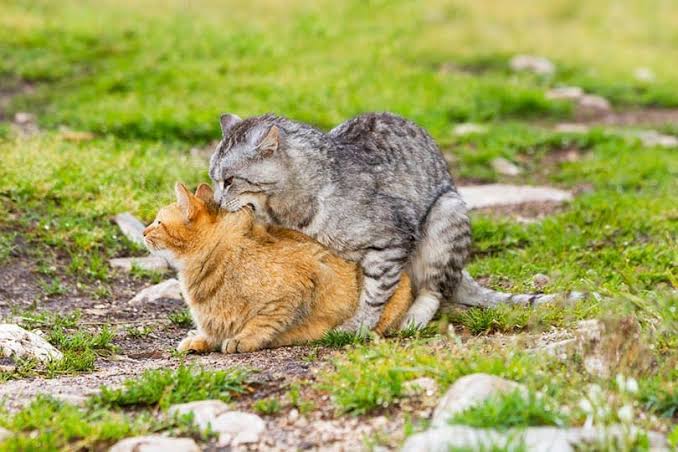In the realm of feline behavior and biology, there are numerous mysteries that continue to intrigue and puzzle cat owners. Do Male Cats Go Into Heat?. That is the question we shall explore in this fascinating topic. Pay close attention as we progress in this article.
Understanding Heat Cycles In Female Cats
Female cats, like many other mammals, undergo reproductive cycles known as heat cycles or estrus cycles. These cycles are governed by hormonal fluctuations and serve the purpose of preparing the female cat’s body for mating and reproduction.
Signs Of Heat
One of the most noticeable signs of a female cat in heat is behavioral changes. She may become more vocal, affectionate, and restless.
Female cats in heat may also exhibit physical signs such as increased grooming of the genital area. This is a position known as lordosis (arching of the back with the hindquarters raised). They also spray urine to attract male cats.

Frequency Of Heat Cycles
Heat cycles in female cats typically occur every two to three weeks during the breeding season. It starts in the beginning of spring and runs through ending of fall.
The duration of each heat cycle can vary but typically lasts around 4-10 days if the female cat does not mate.
Hormonal Changes
During the estrus cycle, the levels of estrogen and progesterone fluctuate in the female cat’s body. This leads to the physical and behavioral changes associated with heat.
Estrogen levels rise prior to and during the estrus phase, triggering the onset of behavioral signs and physical changes.
If the female cat does not mate during the heat cycle, progesterone levels will eventually decline. This signals the end of the cycle and the beginning of the next follicular phase.
Attracting Males
Female cats in heat emit pheromones that can attract male cats from long distances. These pheromones are released through urine marking and vocalizations.
Male cats may respond to these signals by vocalizing, spraying urine, and attempting to locate the female cat in heat.
Importance Of Spaying
Spaying (ovariohysterectomy) is a surgical procedure that removes the ovaries and uterus of a female cat. As a result, it effectively prevents her from going into heat and reproducing.
Spaying not only eliminates the behavioral and physical changes associated with heat cycles. It also helps reduce the risk of certain reproductive disorders and diseases. This includes pyometra (uterine infection) and mammary tumors.
Recommended: How to Know When a Cat is Pregnant: Symptoms Of Early Pregnancy in Cats
The Role Of Hormones In Cat Reproduction
Hormones play a crucial role in regulating the reproductive processes of cats, including both males and females. Understanding how these hormones function can provide insights into the intricate mechanisms behind feline reproduction.
Estrogen:
Estrogen is the primary female sex hormone responsible for regulating the estrous cycle in female cats.
During the follicular phase of the estrous cycle, estrogen levels rise, leading to the development of follicles in the ovaries and the onset of behavioral and physical signs of heat.
Elevated estrogen levels trigger behaviors such as vocalization, increased affection towards male cats, and urine marking to attract potential mates.
Progesterone:
Progesterone is another important hormone involved in female cat reproduction, particularly during the luteal phase of the estrous cycle.
After ovulation, progesterone levels increase, supporting the maintenance of pregnancy and preparing the uterus for embryo implantation.
If the female cat does not conceive, progesterone levels eventually decline, signaling the end of the cycle and the onset of the next follicular phase.
Testosterone:
This is the primary male sex hormone responsible for regulating reproductive functions in male cats.
Testosterone levels influence the development and maintenance of secondary sexual characteristics in male cats, such as the growth of facial hair and the deepening of the voice.
Also, Testosterone plays a role in stimulating mating behaviors, including aggression towards rival males and courtship behaviors towards females in heat.
Gonadotropins:
Gonadotropins are a group of hormones that stimulate the development and function of the gonads (ovaries in females, testes in males).
Follicle-stimulating hormone (FSH) and luteinizing hormone (LH) are two gonadotropins involved in regulating the ovarian and testicular functions in cats.
FSH stimulates the growth and maturation of follicles in female cats, while LH triggers ovulation and the production of sex hormones in both males and females.
Importance Of Hormonal Balance:
Maintaining a proper balance of hormones is essential for normal reproductive function in cats.
Imbalances in hormone levels can disrupt the estrous cycle, leading to irregularities in heat behavior, fertility issues, or reproductive disorders.
Hormonal contraceptives or medications may be prescribed by veterinarians to regulate estrus cycles or manage certain reproductive conditions in cats.

Male Cat Reproductive Behavior
While female cats are known to exhibit clear signs of heat during their reproductive cycles, male cats also display distinct behaviors related to mating and reproduction. Understanding male cat reproductive behavior can provide valuable insights into their natural instincts and interactions with female cats.
Mating Behaviors:
Male cats, known as toms, exhibit specific mating behaviors when they detect a female cat in heat.
One common behavior is vocalization, where male cats may yowl or meow loudly to attract the attention of female cats.
Male cats may also display aggressive behaviors towards rival males to establish dominance and access to females in heat.
Courtship Rituals:
Male cats engage in courtship rituals to persuade female cats to mate with them.
These rituals may include behaviors such as rubbing against the female, sniffing her genital area, and performing a unique mating dance involving circling and vocalization.
Urine Marking:
Male cats use urine marking as a form of communication, particularly during the mating season.
They may spray small amounts of urine on vertical surfaces to leave scent markers that signal their presence to female cats and rival males.
Urine marking helps male cats establish territory and attract potential mates.
Response To Female Cats In Heat:
When a male cat detects the pheromones released by a female cat in heat, he may become highly motivated to seek out and mate with her.
Male cats may roam long distances in search of females in heat, sometimes exhibiting restless behavior and reduced appetite.
Neutering And Its Impact:
Castration or Neutering, is the surgical removal of the testicles in male cats.
Neutering can significantly alter male cat reproductive behavior by reducing or eliminating mating-related behaviors such as roaming, urine marking, and aggression towards other males.
Neutering also helps control the feline population and reduces the risk of certain health issues, including testicular cancer and urinary tract infections.
Recommended: What Colors Can Cats See

Research And Expert Insights On Whether Male Cats Go Into Heat
The question of whether male cats go into heat has intrigued cat owners and researchers alike for years. While it’s widely known that female cats experience heat cycles, there has been ongoing debate and investigation into whether male cats undergo similar reproductive phenomena.
Scientific Studies
Several scientific studies have explored the reproductive physiology of male cats to determine if they exhibit heat cycles comparable to females.
One study published in the Journal of Feline Medicine and Surgery examined hormonal profiles and mating behaviors in intact male cats throughout the breeding season.
Another study conducted by veterinary researchers investigated the presence of estrus-related behaviors and hormonal changes in male cats exposed to female pheromones.
Expert Opinions
Veterinary professionals and feline behavior specialists have provided insights into the reproductive behaviors of male cats based on their clinical experience and observations.
Many experts agree that while male cats do not go into heat in the same way as females, they can still exhibit mating behaviors and respond to the presence of females in estrus.
Male cats may display increased vocalization, restlessness, and territorial marking when exposed to female pheromones during the breeding season.
Hormonal Influences
Hormonal fluctuations play a significant role in regulating reproductive behaviors in male cats, albeit in different ways compared to females.
Testosterone levels in male cats may fluctuate seasonally, peaking during the breeding season when females are in heat.
Elevated testosterone levels can stimulate mating behaviors and aggression towards rival males, contributing to the reproductive success of male cats.
Neutering Effects
Neutering male cats, through surgical castration, can significantly alter their reproductive behaviors and hormone levels.
Neutered male cats are less likely to exhibit mating behaviors, roam in search of females, and engage in territorial marking.
By reducing testosterone levels, neutering helps control the feline population and minimize unwanted mating-related behaviors.

Factors Influencing Male Cat Behavior
Male cat behavior is influenced by a combination of genetic, environmental, and hormonal factors, all of which play significant roles in shaping their reproductive and social behaviors. Understanding these factors can help cat owners better manage and support their male feline companions.
Genetics:
Genetic predispositions can influence male cat behavior, including temperament, aggression levels, and mating tendencies.
Breeds may exhibit specific behavioral traits, such as the Siamese breed known for being vocal and sociable, or the Maine Coon breed known for its gentle and laid-back demeanor.
Hormonal Influences:
Testosterone, the primary male sex hormone, plays a crucial role in regulating male cat behavior, particularly during the breeding season.
Elevated testosterone levels can stimulate mating behaviors, territorial marking, and aggression towards rival males.
Neutering, or castration, can significantly reduce testosterone levels and modify male cat behavior by decreasing mating-related behaviors and territorial aggression.
Socialization And Environment:
Early socialization and environmental experiences shape male cat behavior and sociability.
Cats raised in nurturing and stimulating environments with positive human interactions are more likely to exhibit friendly and sociable behaviors.
Environmental stressors, such as overcrowding, lack of stimulation, or changes in routine, can contribute to anxiety and behavioral issues in male cats.
Health And Wellness:
Physical health and wellness play a crucial role in male cat behavior and overall well-being.
Health conditions such as urinary tract infections, dental problems, and hormonal imbalances can affect mood, appetite, and activity levels.
Regular veterinary check-ups, vaccinations, and preventive care are essential for maintaining optimal health and addressing any underlying medical issues.
Neutering Effects:
Neutering male cats through surgical castration can have significant effects on their behavior and reproductive tendencies.
Neutered male cats are less likely to engage in mating-related behaviors, such as urine marking, roaming, and aggression towards other males.
Neutering also helps control the feline population and reduces the risk of certain health issues, including testicular cancer and sexually transmitted diseases.
Recommended: Is Lemongrass Safe for Cats?
Frequently Asked Questions
Do Male Cats Go Into Heat Like Female Cats?
No, male cats do not experience heat cycles in the same way as female cats. Female cats go into heat to indicate their readiness to mate, whereas male cats exhibit mating behaviors year-round, with heightened activity during the breeding season.
Can Neutering Prevent Male Cats From Exhibiting Mating Behavior?
Yes, neutering, or castration, can prevent male cats from exhibiting mating behaviors and reduce their overall hormone levels. Neutered male cats are less likely to display behaviors associated with mating, such as urine marking and aggression towards other males.
What Age Do Male Cats Start To Exhibit Mating Behaviors?
Male cats can exhibit mating behaviors as early as six months of age, although the onset of these behaviors may vary depending on individual maturity and environmental factors.
How Long Do Male Cats Stay In Heat?
Unlike female cats, male cats do not go through heat cycles. However, they may exhibit mating behaviors year-round, with increased activity during the breeding season.
Will Neutering My Male Cat Change His Behavior?
Neutering can significantly alter male cat behavior by reducing mating-related behaviors, roaming, and territorial aggression. Overall, neutering can lead to a calmer and more contented male cat.
Can Male Cats Still Reproduce After Being Neutered?
Neutering prevents male cats from fathering kittens by removing their ability to produce sperm. Once neutered, male cats are no longer capable of reproducing.
Are There Advantages Of Neutering Male Cats?
Neutering offers several health benefits for male cats, including a reduced risk of testicular cancer, urinary tract infections, and sexually transmitted diseases. It also helps control the feline population and reduces the incidence of unwanted mating-related behaviors.
Conclusion
While male cats do not experience heat cycles in the same way as females, they do exhibit mating behaviors year-round, with heightened activity during the breeding season. Understanding male cat reproductive behavior, including the role of hormones, genetics, and environmental factors, is essential for responsible pet ownership.
Neutering, or castration, plays a crucial role in managing male cat behavior and reproductive tendencies. By reducing testosterone levels and eliminating the risk of unwanted pregnancies, neutering not only benefits individual male cats but also contributes to population control and public health efforts.
As cat owners, it’s important to stay informed about the unique needs and behaviors of our feline companions. Whether opting for neutering or not, providing a nurturing and supportive environment for male cats ensures their health, happiness, and well-being.
